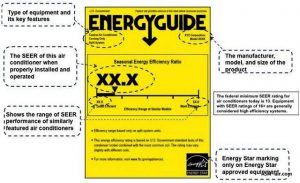What SEER Rating Should I Buy For Our HVAC System
Homeowners today are keen to have appliances and home fixtures that conserve energy. So now, consumers have to understand the SEER rating for air conditioning units. The U.S. government introduced a standard mandating that residential A/C systems made after 2005 should have a seasonal energy efficiency of 13 as the minimum. The regulation was further amended in January 2015, stating that a minimum seasonal energy efficiency rating of 14 is required for air conditioners that will be used in Southeastern and Southwestern states that have hotter climates.
What Is Seasonal Energy Efficiency Rating (SEER) & Where Do I Find It
SEER stands for Seasonal Energy Efficiency Rating. If you’re asking yourself, “What seer rating should I buy?” keep in mind a higher rating means it is more energy-efficient. An A/C with a 16 SEER rating will use less electricity than one with a 14 SEER rating. Every new air conditioning unit comes with a yellow Energy Guide sticker. The seasonal energy efficiency rating is indicated there, included in the model number. An air conditioning unit with a SEER rating of 13 will have a model number that starts with 13AC.
When deciding on what seasonal energy efficiency rating to buy for your Air Conditioner, remember that a higher rating is equivalent to higher efficiency. Of course, this comes with a corresponding price. You will spend more on A/C units with higher ratings. Currently, the highest rating is 25, while the minimum is 13 or 14.
What Seasonal Energy Efficiency Rating Is Suitable For Me
 There are many factors to consider in determining what Air Conditioning rating is suitable for your house. The first thing is the location of your residence, followed by the climate in your area and inside your home, the size of your air conditioning unit, and how long and how often you will be using the air conditioning unit each day.
There are many factors to consider in determining what Air Conditioning rating is suitable for your house. The first thing is the location of your residence, followed by the climate in your area and inside your home, the size of your air conditioning unit, and how long and how often you will be using the air conditioning unit each day.
When you are ready to purchase your next air conditioning unit, the rating will be a key decision that impacts your initial cost. It can be difficult to make the right choice if the salesperson wants to ring up the sale and bombard you with all kinds of information. Most likely, you will receive biased information because the store is pushing some particular brands. This is one of the reasons why it is best to get in touch with a trusted A/C service company like Fischer Heating and Air Conditioning. We provide installation, repair, and maintenance and will give you a straight scoop on SEER ratings. You can be sure of getting the right information, the right choices, the right type of service, and a fair price.
If you intend to shop for a new air conditioning unit on your own, here are a few tips on how to compute the right rating for you before you go to the store.
Simply put, you have to do some simple math computation.
Computation & Comparison
The formula to find the most efficient air conditioning unit for you is to divide the BTUs by the SEER rating. Then divide again by 1000 to get the kWh (kilowatt-hour) you will use per hour. Multiply this by the annual average hours of operation. Multiply the product by the cost of the Kwh of the A/C unit. The computation will reveal how long it will take you to recover your investment on a unit with a higher SEER rating.
As an example, let us compare two units – an air conditioner with a seasonal energy efficiency rating of 13 and one rated 16 to see which one you should buy.
13 SEER
36,000 BTU / 13 SEER = 2769 Watts
2,769 Watts / 1,000 =2.8 Kwh
2,500* Hours P.A. / 2.8 Kwh = 7000 Kwh
7,000 Kwh x .147 * (Per Kwh) = $1,029 Annually
* Ave. Hours Of A/C Operation Annually
**Annual Costs Of Operating A 13 SEER
16 SEER
36000 BTU / 16 SEER = 2,250 Watts
2,250 Watts / 1000 =2.25 Kwh
2,500* Hours P.A. / 2.25 Kwh = 5,625 Kwh
5,625 Kwh x .147 * (Per Kwh) = $827 Annually
* Ave. Hours Of A/C Operation Annually
**Annual Costs Of Operating A 16 SEER
Find the difference between the annual costs:
$1,029 – $827 = $202
Moving on, let us assume that a 13SEER A/C costs $4,200, while a 16SEER unit has a price tag of $6,000. Again you subtract the lower from the higher cost to get the difference, therefore:
$6,000 – $4,200 = $1,800
Divide the difference in cost by the difference in annual Kwh cost:
$1,800 / $202 = 8.9 years – this represents the number of years it will take to realize your ROI (return on investment) for the air conditioning unit with the higher SEER rating.
Things You Should Know About Seasonal Energy Efficiency Ratings
As a homeowner, you want to save as much as you can. So whether you are replacing your old air conditioning unit or planning to have a new system installed, here are some things you should know regarding the seasonal energy efficiency rating and how it can help you save on energy costs.
- You Can Compare Cooling Costs
The cooling power of an air conditioner is defined in British Thermal Units or BTUs/hour. When energy was still cheap, homeowners based their choice of air conditioners on their cooling power. Today, with energy costs going up, homeowners are more concerned about how much energy is consumed to cool a home. With seasonal energy efficiency ratings, a buyer can easily compare the different A/C models’ operating costs. Generally, the more energy-efficient system has a higher rating.
There will be a price jump as the seasonal energy efficiency rating goes higher. But the unit will pay for itself in a few years through the savings on your energy costs.
- Minimum SEER Ratings Differ By Geo Location
More than a decade ago, many air conditioning systems had between 8 to 10 SEER ratings. As technology continues to improve, the minimum SEER rating was about 13 SEER in 2015. Today, the SEER rating is based on the region, as the standard considers the environment, weather, and other conditions that affect the average heating/cooling needs of households in specific regions such as Seattle and the Pacific Northwest.
- Standardized Tests Are The Basis For Seasonal Energy Efficiency Ratings
The standard efficiency test developed by the Department of Energy is used to rate every air conditioner. The test assumes that the indoor temperature is 80 °F, the relative humidity indoors is 50%, and the outdoor temperature is 82 °F. Based on the rating the test arrives at, an A/C with a 15 SEER rating will be 60% more efficient.
However, the efficiency of your system also depends on your location, the condition of your ductwork, and your home insulation.
- Seasonal Energy Efficiency Ratings Go Lower With Time
The efficiency of your air conditioning system becomes lower as the unit gets older, which also decreases its SEER rating. Regular maintenance can extend your system’s lifespan and lower your energy consumption by about 40%.
Admittedly, air conditioning units with higher seasonal energy efficiency ratings will provide energy savings and have an efficient operation. However, it is better to consider how long it will take before you realize the savings against the cost of the unit.
Contact Fischer Heating for any additional questions you may have, or give us a call today at 206-202-9499. to let us help you find the right SEER rating for the Seattle region.
